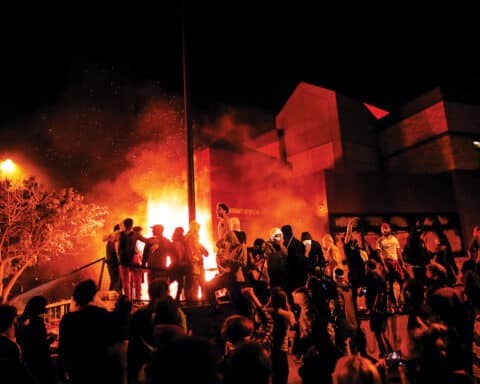News of the Aug. 9 death of Canadian musician Robbie Robertson, at age 80, has rightly prompted many elegant eulogies and thoughtful commemorations. Robertson is best known for heading up the legendary (albeit short-lived) group The Band as its lead guitarist and chief songwriter (though not its lead singer). Robertson’s death leaves 86-year-old Canadian Garth Hudson as the last living member of The Band as it existed from 1968 until it disbanded in 1976. Predeceasing Robertson were fellow Canadians pianist Richard Manuel (1986, aged 42) and bassist Rick Danko (1999, aged 55), and Arkansasan drummer Levon Helm (2012, aged 71), all of whom shared lead vocals from song to song on The Band’s albums.
Beginning with their 1968 debut studio album “Music from Big Pink,” The Band established itself as one of the most important rock ensembles of the late 1960s and early 1970s. Before “Big Pink,” however, The Band’s musicians (then known as The Hawks) emerged as the backup band for Bob Dylan’s raucous and controversial “electric” transition, touring with Dylan from 1965 to 1967. This period helped to propel Dylan’s career, as well as lay the foundation for The Band’s own subsequent success. In 1974, they co-headlined a concert tour, which yielded the excellent live album “Before the Flood.” And Dylan was the centerpiece of The Band’s farewell concert at San Francisco’s Winterland Ballroom on Thanksgiving Day 1976. Planned and executed by Robertson, the concert featured such other luminaries as Van Morrison, Neil Young, Joni Mitchell, Paul Butterfield, Muddy Waters, Eric Clapton, Ronnie Wood and Neil Diamond. Directed and filmed by Martin Scorsese, and interspersed with interviews of The Band’s members, the concert is immortalized in “The Last Waltz,” the finest rock and roll concert documentary film of all time.
A musical yardstick
“Music from Big Pink” was followed by the equally well-regarded albums “The Band” (1969) and “Stage Fright” (1970). Collectively, these three albums yielded such epic songs as “Tears of Rage,” “The Weight,” “This Wheel’s on Fire,” “I Shall Be Released,” “The Night They Drove Old Dixie Down,” “Up on Cripple Creek,” “The Shape I’m In,” “Time to Kill” and “Stage Fright” — the kinds of songs that seem never to have not existed. Indeed, this points to the deeper importance of The Band. Not only did they produce very fine music in their own right, The Band played a critical role in the development and sustenance of what has more recently become known as “Americana,” a hearty mélange of influences drawn from rock, country, jazz, folk and rhythm and blues. The Band was Americana before Americana was cool.
“The Band’s music,” said Martin Scorsese after Robertson’ death, “seemed to come from the deepest place at the heart of this continent, its traditions and tragedies and joys.” When Eric Clapton first heard a bootlegged version of “Big Pink,” he wrote in his 2007 memoir, “It stopped me in my tracks.” Clapton observed that The Band “was really doing it right, incorporating influences from country music, blues, jazz, and rock, and writing great songs. … I was frantically looking for a [musical] yardstick, and here it was.” Elton John concurred: “When I heard The Band’s ‘Music from Big Pink,’ their music changed my life. They … changed the face of music.” When Clapton inducted The Band into the Rock and Roll Hall of Fame in 1989, he said, “for the rest of my career, I tried to imitate what they had.” When Levon Helm died from cancer in 2012, he was eulogized as “the great unifier” by Jeff Tweedy. “He unified blues and country, rural and city, and even North and South,” said Tweety.
Lasting influence
The whole of The Band was greater than the sum of its parts. Their success was a product of their collaboration rather than anyone’s virtuosity. After The Band broke up, only Levon Helm had a noteworthy solo career, winning Grammy awards for each of his albums, “Dirt Farmer” (2007) and “Electric Dirt” (2009). Helm was so highly regarded that at least two other songwriters have immortalized them in their own music. Robert Earl Keen’s “The Man Behind the Drums” and Marc Cohen’s “Listening to Levon” are celebrations of Helm and the legacy of The Band. The rest of The Band enjoyed moderate success as solo acts or studio musicians. And Robertson became better known for his collaborations with Scorsese, writing and directing music for the films “Raging Bull,” “King of Comedy,” “The Color of Money,” “Gangs of New York,” “Wolf of Wall Street” and “The Irishman,” among others.
But for a period of about 10 years, initially as Bob Dylan’s touring band, and then on their own, The Band was at the very center of the emergence of a distinct Americana sound. Under Robertson’s leadership, they were able to tap into several veins of North American culture, distilling them into a uniquely recognizable style, and inspiring generations of singers, songwriters and bands after them. As Robertson wrote in “The Last Waltz Refrain” for the Scorsese documentary, “It’s the last waltz / The last waltz was through / But that don’t mean / That the party is over.” The party continues to benefit us when we find grace in the beauty of Americana songwriting and performance.





